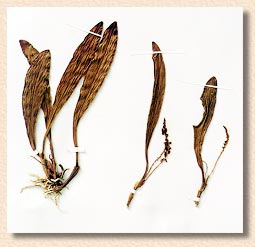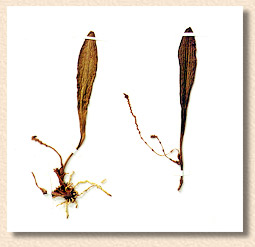


|
 |
||
|
Getting information about a herbarium |
|
Each exemplar of a collection - exsicata - is formed by a vegetal specimen or parts of it that were herbarized, or to put it another way, a vegetal entity, dried, pressed and mounted in a white light cardboard sheet, with a attached card where the characteristics of the collected specimen and the habitat, as well as its classification according to botanical rules are registered. According to the International Code of Botanical Nomenclature, a nomenclatural type is the entity to which the name of a taxon is permanently linked, it could be the correct name or a synonym and it is not obligatorily the more typical specimen or more representative taxon of the species (taxon: any entity taxonomic, without specify the category, it can be a genus, species, etc.). The botanical material collected and stored in a herbarium has some categories of classification. The nomenclatural types (From Latin: typus, i = image, statue) |
A exemplar of type (Typus) is a botanical material collected and stored in a herbarium, used to do the original description (diagnose) of a taxonomic entity, or in another words, this material represents this species and makes it to be known by the scientific community.
"TYPUS (TYPE)" is the general name. |
|
"HOLOTYPUS"
(holo = total) is the resultant excisata (or exsicatae) of the entity collected used to do the description. The researcher decided which one will be used as holotype. Brief, a holotype is the single specimen or illustration used or designated by the author, as the type of a species. |
If the holotype has a duplicate, it is considered as "ISOTYPUS (ISOTYPE)".
Or, if the entity collected has another branch or pseudobulb (for orchids), it will be considered as a isotypus or isotype (isos = equality), with the same number of the holotype register. The isotype is very important and should be send to another herbarium (different from that where the holotype is stored) for safety's sake. This measure is taken in order to guarantee the physical integrality of the type in the event of catastrophe as occurred with the European herbarium during the 2nd World War, specially with Berlin Herbarium. |
There
also is "PARATYPUS (PARATYPE)" (para = proximity, similarity) which is another material that the researcher mentions together with the one he indicated as a holotype. If, for any circumstance, he did not succeed in observing a characteristic of a flower of the holotype or anything else, he needs another material to observe, to compare, so, in this case, he designates the paratype.
In a few words, it is a specimen of a type series other than the holotype, used to compare or to clarify doubts about the species. |
||
 |
 |
|
|
Stellis
-holotypus
|
Stellis
- paratypus
|
|
|
|
|
|
In order to well differentiate isotype and paratype, you should observe that holotype and isotype has the same number in the register and paratype has a different number. Paratype comes from a different "harvest" and could be collected in another area, for example. " PRINCEPS (or principes, one that is first) " is the work where the species has been described, when the species is presented to the science. The researcher collects the plant in the nature, concluded that it is a new species, described it, the description is published in a scientific magazine and it is called the " princeps work ". The description should be done in Latin or at least, the diagnose, differentiating it from the closest species. Brief, the first edition of a work.
Those texts are written based on the interviews given by the volunteers staff of the Herbarium Bradeanum as well as on the printed material written by the same staff.
From left to right: Jorge Fontella Pereira (director), Fernando da Costa Pinheiro, orchid specialist, Miriam Cristina Pereira, biologist and coordinator of projects and Leonor Ribas de Andrade, master in ecology. 
|